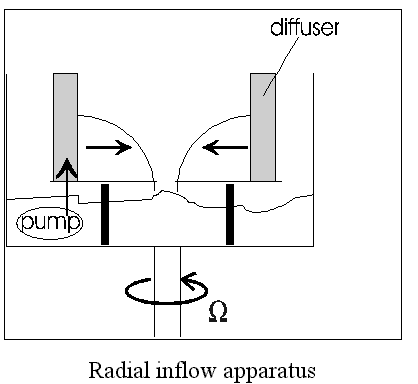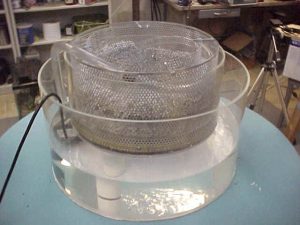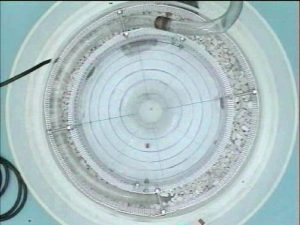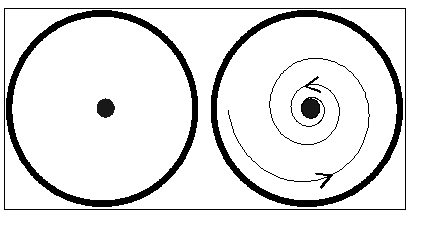GFD LabIII: Radial inflow
For a detailed description of this experiment click here.
Everyone if familiar with the swirl and gurgling sound of water flowing down a drain. In this laboratory experiment we explore this problem quantitatively and draw out the strong parallels between it and the large scale flow in the atmosphere and ocean. We rotate a cylinder about its vertical axis: the cylinder has a circular drain hole in the center of its bottom. Water enters through a diffuser on the outer wall of the cylinder. The water is supplied by the diffuser at a constant rate so that a steady state can be set up in which the flow down the central drain exactly balances the inflow from the outer edge.

The swirling flow set up exhibits a number of important principles of rotating fluid dynamics – conservation of angular momentum, geostrophic and cyclostrophic balance and Ekman layers.
The experiment described here was designed by Jack Whitehead of the Woods Hole Oceanographic Institution. For more details refer to Whitehead, J.A and Potter, D.L (1977) Axisymmetric critical withdrawal of a rotating fluid. Dynamics of Atmospheres and Oceans, 2, 1-18.
The apparatus
Take a roughly 40 cm cylindrical tank of approximately 15 cm depth with a drain hole in the center of the bottom. A diffuser with 30 cm inside diameter is constructed of wire screen, placed in the tank, and stones approximately 1cm in size used to fill the space between the screen and the outer wall of the tank. Water is then fed in to the bottom of the rock bed through a loop hose with numerous holes (roughly 0.5 cm diameter), so that water is fed evenly in to the bottom of the diffuser. The diffuser is effective at producing an axially-symmetric, inward velocity at the screen.
Below the tank place a large catch basin, partially filled with water and containing a submersible pump whose purpose is to feed water to the diffuser in the upper tank.
The entire apparatus is then mounted on a turntable.
Typical flow patterns
When the apparatus is not rotating water flows radially inward from the diffuser to the drain in the middle. When the apparatus is set rotating, however, water in the interior conserves angular momentum and, in so doing, acquires a vigorous swirling motion. The water spirals inward, as sketched in the diagram. The centrifugal force directed radially outward is balanced by a pressure gradient force directed radially inwards. This pressure gradient force is set up by the free surface tilting relative to the horizontal.




